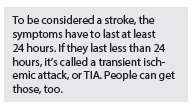Bigstock


“It’s one of those conditions that, with the advent and then greater usage of MRI, we’re starting to figure out that dogs truly do have strokes, probably with a greater frequency than we once thought,” says veterinary neurologist Casey Neary, DVM, DACVIM, who works out of the Atlanta offices of Bush Veterinary Neurology Service, the largest veterinary neurological practice in the world. To be sure, Dr. Neary says, “the overall occurrence of stroke is rare, not as common as in humans.” But if your dog is one of those afflicted, you certainly want to know what signs to look for so you can get him treatment as soon as possible.
Just what is a stroke? Which dogs are more prone?
When a blood vessel within the brain or leading to it is either blocked by a clot or bursts, the blood is kept from bathing all parts of that organ with oxygen and nutrients, and brain function suffers. A dog might suddenly experience vertigo, an abnormal gait, seizures, or blindness.
Which breeds are most likely to be affected has not been nailed down with any scientific certainty — most of the research on stroke in dogs has been conducted only during the last 10 years (prior to that it was all autopsy studies, Dr. Neary says). Veterinary neurologists have observed in clinical settings that males appear to be at greater risk than females, as is the case with humans. Furthermore, older dogs are more prone than younger ones. “If a three-year-old Chihuahua comes in with neurological symptoms, a stroke is not going to be high on my list” of possibilities, Dr. Neary says. “I’d be more likely to suspect encephalitis — inflammation of the brain.”
As far as breed propensity, while a dog of any breed can have a stroke, “the two breeds over-represented in the literature are greyhounds and Cavalier King Charles spaniels,” in that order, the doctor notes.
Veterinary researchers hypothesize that greyhounds may be at increased risk because they have higher resting blood pressure than other dogs, and high blood pressure is a stroke risk factor. When it comes to Cavalier King Charles spaniels, it is believed that the greater proportion of strokes observed in that breed may be associated with the fact that many of them have a heart condition stemming from a faulty heart valve. They also tend to have an inherent skull malformation characterized by abnormal growth of the bone at the back of the skull. In addition, their blood platelets are three to four times the size of normal canine platelets. It’s not known whether there is a cause-and-effect relationship. These are just some avenues of exploration researchers are considering.
Unfortunately, there’s not much a dog owner can do to prevent a stroke in a canine companion. In people, keeping down blood pressure is key. But dogs don’t tend to have high blood pressure unconnected to other health issues. Usually high blood pressure in dogs is a result of kidney disease, adrenaline-secreting adrenal tumors, or Cushing’s disease, so theoretically, if you stay on top of your dog’s health with any of those conditions, you’re staying on top of stroke risk.
The thing is, says Dr. Neary, “we actually find a cause in fewer than 50 percent of cases, even when we identify a stroke in a greyhound or Cavalier King Charles. The highest percentage of canine strokes are what we call idiopathic, meaning of unknown cause.”
Honing in on symptoms
What stroke signs a dog exhibits depends on what area of the brain is affected. The most commonly affected area is the cerebellum, in the back of the brain. That’s where canine strokes occur “almost 50 percent of the time,” Dr. Neary says. Since the cerebellum is all about balance, balance disorders are therefore the most typical stroke symptom. “The dog can be showing vertigo or gait abnormalities,” Dr. Neary comments. “Often it’s a kind of high-stepping gait, like a goose step, sometimes accompanied by head tremors.” Why the unusual gait?
“The cerebellum controls range and force of limb movement,” the doctor explains. “It’s a regulator. It helps smooth what we intend to do and what we try to do. So when something goes wrong there, movements can become exaggerated,” that is, without smoothness.
The second most common area in the brain for a stroke to hit is the cerebrum, which is in the forebrain at the front of the head. In that case, the symptom is often seizures — or circling, or cognitive changes in the form of disorientation. Strokes in the cerebrum account for “probably 25 percent” of canine strokes, Dr. Neary says.
The rest of strokes in dogs occur in various parts of the brain in much smaller percentages, causing a variety of neurologic symptoms. These include everything from vision loss to weakness or paralysis of one or more limbs.
No matter where the stroke occurs, 80 percent of them are termed ischemic, meaning they are characterized by a blockage, or clot. The other 20 percent are called hemorrhagic — a blood vessel actually ruptures, causing ongoing bleeding, or blood congeals into a hematoma that presses on the brain. The proportion is the same as in people, with the same implications: hemorrhagic strokes are more dire and come with a much worse prognosis for recovery.
That’s why it’s good that they’re much more rare than ischemic strokes — although not quite as rare if you live in Europe, Dr. Neary says. A parasite there called the French heartworm increases the risk for hemorrhagic stroke in dogs. In fact, Dr. Neary notes, the French heartworm is “the most common cause of hemorrhagic stroke in all animals across the planet. The worms get into the animal systemically, and then the animal has a tendency to bleed because clotting factors are decreased. Because we don’t have the French heartworm here, hemorrhagic stroke is rarely seen in pets across the U.S.”
Getting a proper diagnosis
There are many reasons a dog could have neurological symptoms such as balance problems — a tumor, encephalitis, vestibular disease, among them — and they each have their own course of treatment. So if you see something amiss with your dog in terms of gait, balance, seizures, or other signs that appear neurological in nature, get him to the vet as soon as possible so the doctor can get right on a proper diagnosis.


When you arrive, the vet will ask some questions whose answers will help get to the root of the problem. One of the most important questions will be whether the onset of the symptoms was very sudden and whether they have stayed pretty much at their current intensity. “If the illness fits the story of a very sudden onset that wasn’t progressive but instead immediately reached its current point, a stroke would be on the higher end of my list” as a possible cause, Dr. Neary says. Strokes don’t come on gradually, or by degrees, and the severity of the symptoms peaks very early in the process. That is, the dog goes from “normal to abnormal almost instantaneously, with the highest severity right at the beginning,” he comments. Something like encephalitis, by contrast, starts out slowly, gradually, with symptoms worsening over a period of days.
But the diagnosis cannot be made by understanding the nature of the symptoms alone. “MRI is the gold standard diagnostic test for a stroke,” Dr. Neary points out. “Strokes went largely undiagnosed before MRI for dogs.”
MRI does not come cheap. Including anesthesia, the price can top $1,500 (a good reason to buy health insurance for your pet while he is still young). But the rapid diagnosis it can provide is critical. “Time is key for treatment, supportive care, and treating secondary conditions” that may have raised blood pressure and led to the stroke or, conversely, resulted from the stroke, Dr. Neary says.
Treatment protocol
Once a stroke has been diagnosed, “we don’t do anything to address the actual blood clot,” Dr. Neary says. The focus is largely on supportive care. (“It’s recommended that the pet stay in the hospital overnight for monitoring,” Dr. Neary notes.) Treatment is also aimed at limiting any secondary brain damage that may have occurred. This could include edema (too much water buildup in the brain), undue pressure in the brain because of the uneven blood flow, and seizures.
Seizures are treated with medicine, and Dr. Neary is happy to report that there are two new anti-seizure medications that are not only efficacious but also very well tolerated and associated with very little in the way of side effects. They are called Keppra (levetiracetam) and Zonegran (zonisamide).
Going forward
The good news is that most times, “a stroke is not actually a death sentence,” Dr. Neary says. “Eighty percent of dogs will recover. The times a dog doesn’t do well involve multiple strokes or the occlusion of a very large blood vessel.” But in most cases, the dog goes back to being the dog he was before the symptoms appeared. They will start to dissipate within days to weeks.





